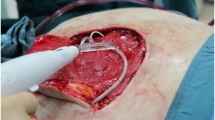Abstract
The VAC-therapy is a safe, easy, and effective therapy for the management of chronic wounds. Known advantages of the VAC technique are the quicker wound healing by stimulating the blood flow, the formation of granulation tissue, angiogenesis, and cell proliferation. The use of negative pressure treatment can decrease the number of dressing changes and length of hospital stay. However, some related complications after and during VAC therapy have been described. We here describe a rare complication during the treatment of severe os ischium sore with VAC therapy, which has not been reported in the literature yet. We report about a 43-year-old paraplegic patient, referred to our clinic from a regional hospital where he had been admitted 2 months earlier, presenting with a necrotizing fasciitis after VAC therapy during the treatment of fourth grade os ischium sore. After operative debridement and long-term antibiotics with Ciprofloxacin soft tissue closure was performed using a myocutaneous tensor fascia lata flap. Temporary stabilization was achieved by a triangle external fixateur attached to the right femur and the pelvis. After 1 week the tapping point of the muscle flap could be covered with local skin mesh-graft from the right calf as a donor site. The patient was mobilized in a wheelchair and was discharged home 3 months after admission. The VAC technique is a safe, easy, and effective means in chronic wound care management. However, the described rare complication should be kept in mind. The clinical management of VAC therapy requires a distinct indication and close clinical monitoring by experienced medical professionals. The use of VAC therapy in fourth grade sores may have deleterious consequences for the patient.







Similar content being viewed by others
References
Argenta PA, Rahaman J, Gretz HF III, Nezhat F, Cohen CJ (2002) Vacuum-assisted closure in the treatment of complex gynecologic wound failures. Obstet Gynecol 99:497–501
Braakenburg A, Obdeijn MC, Feitz R, van Rooij IA, van Griethuysen AJ, Klinkenbijl JH (2006) The clinical efficacy and cost effectiveness of the vacuum-assisted closure technique in the management of acute and chronic wounds: a randomized controlled trial. Plast Reconstr Surg 118:390–397 discussion 398–400
de Leon J (2005) Negative pressure wound therapy in pressure ulcer management. Ostomy Wound Manag 51:3–8
Flack S, Apelqvist J, Keith M, Trueman P, Williams D (2008) An economic evaluation of VAC therapy compared with wound dressings in the treatment of diabetic foot ulcers. J Wound Care 17:71–78
Fleischmann W, Strecker W, Bombelli M, Kinzl L (1993) Vacuum sealing as treatment of soft tissue damage in open fractures. Unfallchirurg 96:488–492
Garner GB, Ware DN, Cocanour CS, Duke JH, McKinley BA, Kozar RA, Moore FA (2001) Vacuum-assisted wound closure provides early fascial reapproximation in trauma patients with open abdomens. Am J Surg 182:630–638
Harlan JW (2002) Treatment of open sternal wounds with the vacuum-assisted closure system: a safe, reliable method. Plast Reconstr Surg 109:710–712
Isago T, Nozaki M, Kikuchi Y, Honda T, Nakazawa H (2003) Negative-pressure dressings in the treatment of pressure ulcers. J Dermatol 30:299–305
Philbeck TE Jr, Whittington KT, Millsap MH, Briones RB, Wight DG, Schroeder WJ (1999) The clinical and cost effectiveness of externally applied negative pressure wound therapy in the treatment of wounds in home healthcare Medicare patients. Ostomy Wound Manag 45:41–50
Smith N (2004) The benefits of VAC therapy in the management of pressure ulcers. Br J Nurs 13:1359–1365
Webb LX (2002) New techniques in wound management: vacuum-assisted wound closure. J Am Acad Orthop Surg 10:303–311
Webb LX, Schmidt U (2001) Wound management with vacuum therapy. Unfallchirurg 104:918–926
Wild T, Otto F, Mojarrad L, Kellner M, Gotzinger P (2007) Vacuum therapy—basics, indication, contraindication and cost listing. Ther Umsch 64:495–503
Author information
Authors and Affiliations
Corresponding author
Rights and permissions
About this article
Cite this article
Citak, M., Backhaus, M., Meindl, R. et al. Rare complication after VAC-therapy in the treatment of deep sore ulcers in a paraplegic patient. Arch Orthop Trauma Surg 130, 1511–1514 (2010). https://doi.org/10.1007/s00402-010-1091-6
Received:
Published:
Issue Date:
DOI: https://doi.org/10.1007/s00402-010-1091-6




